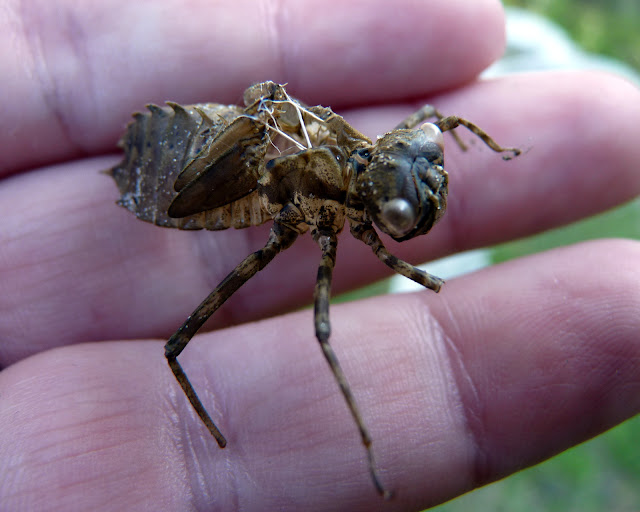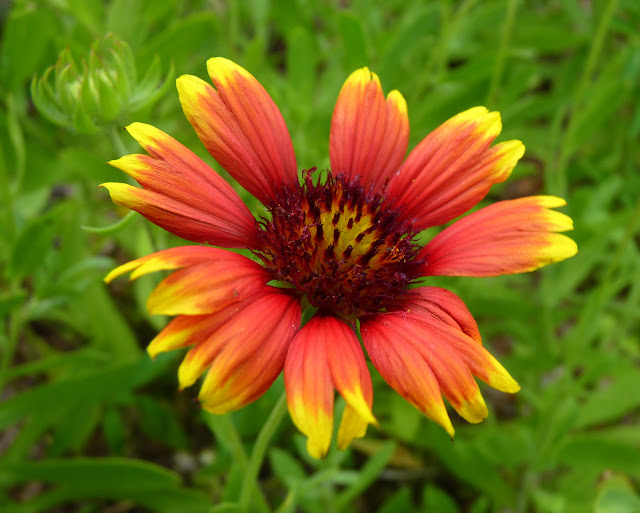An online journal of our quest to make a tiny piece of Florida suburbia into a wildlife-friendly oasis.
Wednesday, May 30, 2012
Monday, May 28, 2012
Walk the Line
We see a lot of birds in My Florida Backyard, especially wading birds around the edge of the pond. Some wading birds, like White Ibis, are known to wander up into the yard looking for lunch, but most of the egrets and herons are much more common along the shore. So we were a little surprised to find this Little Blue Heron walking the fence like an acrobat the other day.
Little Blue Herons (Egretta caerulea) are common on Florida's shorelines, both salt and fresh. They're also found west to Texas and up the Atlantic Coast to Virginia and even further north in the summer. They grow to about two feet tall, with a wingspan of about three to four feet.
One of the most interesting things about the Little Blue Heron is that its immature form is pure white. It's possible to confuse it with a Snowy Egret at this point, but Snowy Egrets have yellow feet and yellow at the base of their beak, so as long as you get a good look, it's pretty easy to tell them apart. As it matures, the Little Blue Heron takes on a mottled appearance as the feathers darken to the iridescent blue of the adult bird.
Little Blues feed on small fish and other shoreline creatures. Up on dry land, working its way along the fence, this bird was most likely looking for insects or lizards to snack on. We're always glad to see wildlife finding what it needs to survive right here in My Florida Backyard!
Little Blue Herons (Egretta caerulea) are common on Florida's shorelines, both salt and fresh. They're also found west to Texas and up the Atlantic Coast to Virginia and even further north in the summer. They grow to about two feet tall, with a wingspan of about three to four feet.
One of the most interesting things about the Little Blue Heron is that its immature form is pure white. It's possible to confuse it with a Snowy Egret at this point, but Snowy Egrets have yellow feet and yellow at the base of their beak, so as long as you get a good look, it's pretty easy to tell them apart. As it matures, the Little Blue Heron takes on a mottled appearance as the feathers darken to the iridescent blue of the adult bird.
Little Blues feed on small fish and other shoreline creatures. Up on dry land, working its way along the fence, this bird was most likely looking for insects or lizards to snack on. We're always glad to see wildlife finding what it needs to survive right here in My Florida Backyard!
Wednesday, May 23, 2012
Wordless Wednesday: I Saw the Sign
OK, just a few words. We got these at the FNPS Annual Conference sale in Plant City last weekend. Visit the Rustables website to learn more about the artist and the art!
Monday, May 21, 2012
Ro Ro Rosy
We love exploring the shore of our pond, looking for new wildflowers we haven't noticed before. Today's discovery is Rosy Camphorweed (Pluchea baccharis).
The Latin name "baccharis" means "fragrant root", although it doesn't really specify just how pleasant the fragrance is. A quick sniff of the crushed foliage will make the origin of the common name obvious immediately, though the flowers have a light sweet smell and are a draw for small butterflies and other pollinators.
Rosy Camphorweed is a plant of the wetlands. It requires consistently moist soil and can tolerate occasional salt exposure. It grows anywhere from one to three feet in height, and is found throughout the southeast U.S. You might find it for sale at native plant nurseries, especially those that specialize in wildflowers. Now that we've identified it, though, we're noticing it all over the place, so take a look around... maybe you'll find some in your own backyard!
The Latin name "baccharis" means "fragrant root", although it doesn't really specify just how pleasant the fragrance is. A quick sniff of the crushed foliage will make the origin of the common name obvious immediately, though the flowers have a light sweet smell and are a draw for small butterflies and other pollinators.
Friday, May 18, 2012
Empty Shell
While filling the bird feeder today, we found an empty insect exoskeleton clinging to the bottom. (It almost seems to have a golden glow here, but that's just the effect of the camera flash.)
Our first instinct, from past experience, was that it must be a cicada shell. But something didn't seem quite right; the legs were too long, the body not chubby enough.
A few internet searches later, we felt reasonably certain in stating this this was instead the exuvia, or final shed exoskeleton, of a dragonfly, although we can't be certain of the species. It's not uncommon for a dragonfly nymph to crawl some distance away from the water to undergo its final transformation. We detached it carefully to take a closer look.
Here's a closeup of the incredibly detailed head, with staring eye capsules front and center and the tiny antenna clearly delineated:
When we flipped the shell over, the mandible was obviously visible too:
The wings seem too small and the body section too large, until you remember that when the dragonfly emerges, it pumps fluid (haemolymph) from its body into its wings to expand and inflate them. (See great photography of this process here.)
The incredible detail left behind on the exuvia shows what an intricate creature the resulting dragonfly truly is. We've admired them as adults many times, and we love knowing that My Florida Backyard plays a role in their life cycle beyond just providing yummy mosquitoes for their dinners!
Wednesday, May 16, 2012
Sunday, May 13, 2012
Walk Tall
We came around the corner of the house this afternoon to find a very tall bird visitor in My Florida Backyard.
Great Egrets (Ardea alba) are common wading in the shallows on the edge of our lake, but they sometimes wander up into our yard as well. In the lake, they'll target fish, frogs, and other small water creatures. On dry land, their prey include lizards and snakes.
Great Egrets are found around the world. In the U.S., they are seen in much of the country during migration and summer months, but in Florida and along the whole Gulf Coast, we're lucky enough to have them in residence year-round.
The Great Egret is the symbol of the National Audubon Society. When the society was founded in 1905, one of its major goals was to protect birds like the Great Egret from being killed for their tail feathers. These gorgeous plumes were eagerly sought by society women to trim their hats, and egrets and others were slaughtered in huge numbers (their populations plummeted by up to 95 percent) and left to rot after their feathers were harvested. Society founder George Grinnell was appalled by the carnage, and founded the society to protect them.
Today, Great Egrets thrive in Florida's wetlands, and are a common sight just about everywhere - we see them daily in My Florida Backyard. They are a true testament to what caring conservationists can accomplish when they inspire those around them to care as well.
Great Egrets (Ardea alba) are common wading in the shallows on the edge of our lake, but they sometimes wander up into our yard as well. In the lake, they'll target fish, frogs, and other small water creatures. On dry land, their prey include lizards and snakes.
Great Egrets are found around the world. In the U.S., they are seen in much of the country during migration and summer months, but in Florida and along the whole Gulf Coast, we're lucky enough to have them in residence year-round.
The Great Egret is the symbol of the National Audubon Society. When the society was founded in 1905, one of its major goals was to protect birds like the Great Egret from being killed for their tail feathers. These gorgeous plumes were eagerly sought by society women to trim their hats, and egrets and others were slaughtered in huge numbers (their populations plummeted by up to 95 percent) and left to rot after their feathers were harvested. Society founder George Grinnell was appalled by the carnage, and founded the society to protect them.
Today, Great Egrets thrive in Florida's wetlands, and are a common sight just about everywhere - we see them daily in My Florida Backyard. They are a true testament to what caring conservationists can accomplish when they inspire those around them to care as well.
Wednesday, May 9, 2012
Saturday, May 5, 2012
Catch Up
My calendar tells me it is now the month of May. It's always been reliable before, so I have to believe what it says, but I'm a little alarmed by the fact that the month of April is gone. Here in My Florida Backyard, April was a blur of a month, filled with out-of-town guests, broken air conditioning, hectic times at work, and heavy-hitting cough-filled colds that are still dragging on long after it seems they should be. We've pretty much had to leave the gardens to fend for themselves, and for the most part they seemed to do fine without us.
Fortunately, we've been able to poke our heads out from time to time to see what's been going on, so we caught the first blooming of our new Salvia greggii 'Ultraviolet', which we ordered from Park Seed a few months ago.
The color really seems to live up to what was advertised in the catalog, though I'm not sure it really shows up properly in this picture. It's definitely not like any other salvia we have in the gardens (and we have plenty!). We haven't been giving it a whole lot of supplemental water throughout this dry season, so we look forward to seeing what size it will reach once the rains kick in.
We're hoping that with a return to normal schedules and somewhat normal health, we'll be able to get back out into the gardens again to give them the TLC they need to make it through May, which is a notoriously difficult month in Florida. Hot temps combined with low rainfall can wreak havoc on plants, but most of our natives should be well-equipped to handle whatever May throws their way. We hope we can do the same!
Fortunately, we've been able to poke our heads out from time to time to see what's been going on, so we caught the first blooming of our new Salvia greggii 'Ultraviolet', which we ordered from Park Seed a few months ago.
The color really seems to live up to what was advertised in the catalog, though I'm not sure it really shows up properly in this picture. It's definitely not like any other salvia we have in the gardens (and we have plenty!). We haven't been giving it a whole lot of supplemental water throughout this dry season, so we look forward to seeing what size it will reach once the rains kick in.
We're hoping that with a return to normal schedules and somewhat normal health, we'll be able to get back out into the gardens again to give them the TLC they need to make it through May, which is a notoriously difficult month in Florida. Hot temps combined with low rainfall can wreak havoc on plants, but most of our natives should be well-equipped to handle whatever May throws their way. We hope we can do the same!
Wednesday, May 2, 2012
Subscribe to:
Posts (Atom)





































